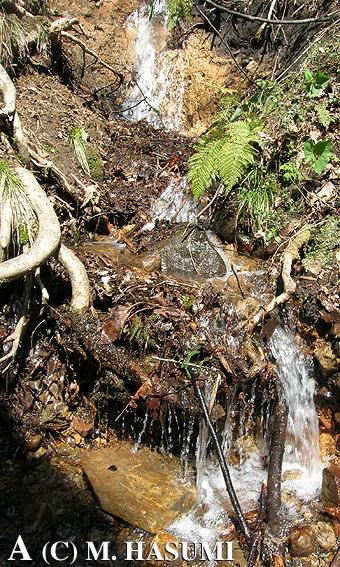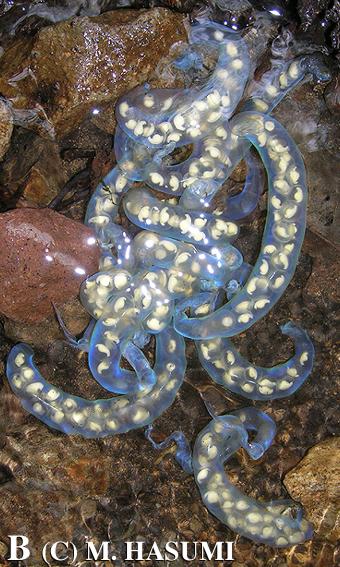

 |  |
(A) A torrent (water temperature = 7.8 C, water pH-data = 6.1-7.2), just flowing like a fall, at least in three places (photographed on 4 May 2006).
All organisms around the torrent were as follows:
H. kimurae:
(1) 4 males under a stone or among egg sac mass in the torrent,
(2) 1 unsexed individual in the torrent,
(3) 7 overwintering larvae in a flat place of the torrent,
(4) 1 pair of egg sacs, the adhesive tips of which were attached to a small stone (7 x 5 x 3.5 cm) in the torrent, 33.8 m upper from the 2005 oviposition site (22 and 24 embryos at the early neural-fold stage),
(5) 3 pairs of egg sacs, the adhesive tips of which were attached to a stone covered with mud in the torrent, 1.4 m lower from the 2005 oviposition site (9-27 embryos from the late neural-fold stage to the early tail-bud stage), and
(6) 8 pairs of egg sacs, the adhesive tips of which were attached to two stones covered with considerable amounts of gravel, hidden under the right bank of the torrent, 1.0 m lower from the oviposition site having the 3 pairs mentioned above (12-24 embryos from the late neural-fold stage to the early tail-bud stage);
Rana ornativentris:
(1) 9 juveniles in the torrent; and
Rana tagoi:
(1) 1 male in the torrent, and
(2) 1 juvenile among decaying leaves above ground on land 30 cm from the torrent.
(B) Egg sac mass (embryos at the late or elongated tail-bud stage) of H. kimurae, moved from the two hidden sites of oviposition to an open site in the torrent (water temperature = 8.4 C, water pH = 6.9) for examining developmental stages of embryos (photographed on 20 May 2006). At the time of examination, a seeming male of H. kimurae was dead above ground on land 30 cm from the torrent.
Accompanied Research Collaborators (alphabetical order): Iwao Hasegawa (Takefu, Fukui Prefecture), Masaichi Kakegawa (Tokyo Metropolitan Komatsugawa Senior High School), Fujio Kishi and Yuko Saikawa (Shirouma Association of Naturalists), and Koji Takada (Nagano Chausuyama Zoo).